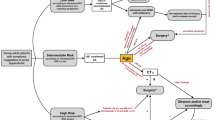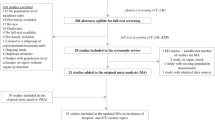Abstract
Introduction
Faecal peritonitis (FP) is a common cause of sepsis and admission to the intensive care unit (ICU). The Genetics of Sepsis and Septic Shock in Europe (GenOSept) project is investigating the influence of genetic variation on the host response and outcomes in a large cohort of patients with sepsis admitted to ICUs across Europe. Here we report an epidemiological survey of the subset of patients with FP.
Objectives
To define the clinical characteristics, outcomes and risk factors for mortality in patients with FP admitted to ICUs across Europe.
Methods
Data was extracted from electronic case report forms. Phenotypic data was recorded using a detailed, quality-assured clinical database. The primary outcome measure was 6-month mortality. Patients were followed for 6 months. Kaplan–Meier analysis was used to determine mortality rates. Cox proportional hazards regression analysis was employed to identify independent risk factors for mortality.
Results
Data for 977 FP patients admitted to 102 centres across 16 countries between 29 September 2005 and 5 January 2011 was extracted. The median age was 69.2 years (IQR 58.3–77.1), with a male preponderance (54.3 %). The most common causes of FP were perforated diverticular disease (32.1 %) and surgical anastomotic breakdown (31.1 %). The ICU mortality rate at 28 days was 19.1 %, increasing to 31.6 % at 6 months. The cause of FP, pre-existing co-morbidities and time from estimated onset of symptoms to surgery did not impact on survival. The strongest independent risk factors associated with an increased rate of death at 6 months included age, higher APACHE II score, acute renal and cardiovascular dysfunction within 1 week of admission to ICU, hypothermia, lower haematocrit and bradycardia on day 1 of ICU stay.
Conclusions
In this large cohort of patients admitted to European ICUs with FP the 6 month mortality was 31.6 %. The most consistent predictors of mortality across all time points were increased age, development of acute renal dysfunction during the first week of admission, lower haematocrit and hypothermia on day 1 of ICU admission.
Similar content being viewed by others
References
Baron MJ, Kasper DL (2011) Intraabdominal infections and abscesses. In: Longo D, Fauci A, Kasper D, Hauser S, Jameson J, Loscalzo J (eds) Harrison’s principles of internal medicine. McGraw-Hill, New York
Calandra T, Cohen J (2005) The international sepsis forum consensus conference on definitions of infection in the intensive care unit. Crit Care Med 33:1538–1548
Vincent JL, Sakr Y, Sprung CL, Ranieri VM, Reinhart K, Gerlach H, Moreno R, Carlet J, Le Gall JR, Payen D (2006) Sepsis in European intensive care units: results of the SOAP study. Crit Care Med 34:344–353
Pacelli F, Doglietto GB, Alfieri S, Piccioni E, Sgadari A, Gui D, Crucitti F (1996) Prognosis in intra-abdominal infections. Multivariate analysis on 604 patients. Arch Surg 131:641–645
Koperna T, Schulz F (2000) Relaparotomy in peritonitis: prognosis and treatment of patients with persisting intraabdominal infection. World J Surg 24:32–37
Ohmann C, Wittmann DH, Wacha H (1993) Prospective evaluation of prognostic scoring systems in peritonitis. Peritonitis Study Group. Eur J Surg 159:267–274
Demmel N, Maag K, Osterholzer G (1994) Wertigkeit klinischer parameter zur prognosebeurteilung der peritonitis—Validierung des Mannheimer Peritonitis-Index [Probability of clinical prognostic factors in peritonitis—evaluation of the Mannheim Peritonitis-Index]. Langenbecks Archiv für Chirurgie 379:152–158
Billing A, Frohlich D, Schildberg FW (1994) Prediction of outcome using the Mannheim peritonitis index in 2003 patients. Peritonitis Study Group. Br J Surg 81:209–213
van Ruler O, Kiewiet J, Boer K, Lamme B, Gouma D, Boermeester M, Reitsma J (2011) Failure of available scoring systems to predict ongoing infection in patients with abdominal sepsis after their initial emergency laparotomy. BMC Surg 11:1–9
Singh R, Kumar N, Bhattacharya A, Vajifdar H (2011) Preoperative predictors of mortality in adult patients with perforation. Indian J Crit Care Med 15:157–163
van Ruler O, Mahler C, Boer K, Reuland E, Gooszen H, Opmeer B, de Graaf P, Lamme B, Gerhards M, Steller E, van Till J, de Borgie C, Gouma D, Reitsma J, Boermeester M, Group DPS (2007) Comparison of on-demand vs planned relaparotomy strategy in patients with severe peritonitis: a randomized trial. JAMA 298:865–872
Pawa N, Jadidi M, Konarzewski W, Tutton MG, Motson RW (2009) Outcome of faecal peritonitis admissions to a critical care unit: an 18-year analysis. In: Abstracts of the Association of Coloproctology of Great Britain and Ireland annual meeting, vol 11, no 5, pp 1462–8910
Sayer J, Simpson G, McCrossan L, Welters I (2012) Outcome of faecal peritonitis in the ICU. Crit Care 16(Suppl 1):P398. doi:10.1186/cc11005
Knaus WA, Draper EA, Wagner DP, Zimmerman JE (1985) APACHE II: a severity of disease classification system. Crit Care Med 13:818–829
Linder M, Wacha H, Wesch G, Feldmann U (1986) Pertinent clinical parameters influencing mortality in bacterial peritonitis: mannheim peritonitis index (MPI). Langenbeck’s Arch Surg 369:788
Wittmann DH, Teichmann W, Müller M (1987) 176. Entwicklung und Validierung des Peritonitis-Index-Altona (PIA II). Langenbeck’s Arch Surg 372:834–835
Elebute EA, Stoner HB (1983) The grading of sepsis. Br J Surg 70:29–31
Tridente A, Clarke G, Walden A, McKechnie S, Hutton P, Martynoga R, Mills G, Gordon A, Stueber F, Garrard C, Hinds C (2011) Epidemiology of faecal peritonitis in the GenOSept cohort, European Society of Intensive Care Medicine (ESICM) annual conference, Berlin.http://poster-consultation.esicm.org/ModuleConsultationPoster/posterDetail.aspx?intIdPoster=2769. Accessed 26 July 2013
Levy M, Fink M, Marshall J (2003) 2001 SCCM/ESICM/ACCP/ATS/SIS international sepsis definitions conference. Crit Care Med 31:1250–1256
Vincent JL, Moreno R, Takala J, Willatts S, De Mendonca A, Bruining H, Reinhart CK, Suter PM, Thijs LG (1996) The SOFA (Sepsis-related Organ Failure Assessment) score to describe organ dysfunction/failure. On behalf of the Working Group on Sepsis-Related Problems of the European Society of Intensive Care Medicine. Intensive Care Med 22:707–710
Schoenfeld D (1982) Partial residuals for the proportional hazards regression model. Biometrika 69:239–241
Therneau TM, Grambsh PM (2000) Modeling survival data: extending the Cox model. Springer, New York
Angus D, Kelley M, Schmitz R (2000) Caring for the critically ill patient. Current and projected workforce requirements for care of the critically ill and patients with pulmonary disease: can we meet the requirements of an aging population? JAMA 284:2762–2770
Rosenthal G, Kaboli P, Barnett M (2002) Age and the risk of in-hospital death: insights from a multihospital study of intensive care patients. J Am Geriatr Soc 50:1205–1212
Van Den Noortgate N, Vogelaers D, Afschrift M, Colardyn F (1999) Intensive care for very elderly patients: outcome and risk factors for in-hospital mortality. Age Ageing 28:253–256
Uchino S, Kellum JA, Bellomo R, Doig GS, Morimatsu H, Morgera S, Schetz M, Tan I, Bouman C, Macedo E, Gibney N, Tolwani A, Ronco C (2005) Acute renal failure in critically ill patients: a multinational, multicenter study. JAMA 294:813–818
Metnitz PG, Krenn CG, Steltzer H, Lang T, Ploder J, Lenz K, Le Gall JR, Druml W (2002) Effect of acute renal failure requiring renal replacement therapy on outcome in critically ill patients. Crit Care Med 30:2051–2058
Ostermann M, Chang R (2008) Correlation between the AKI classification and outcome. Crit Care 12:R144
Barrantes F, Tian J, Vazquez R, Amoateng-Adjepong Y, Manthous CA (2008) Acute kidney injury criteria predict outcomes of critically ill patients. Crit Care Med 36:1397–1403
Laupland KB, Zahar JR, Adrie C, Schwebel C, Goldgran-Toledano D, Azoulay E, Garrouste-Orgeas M, Cohen Y, Jamali S, Souweine B, Darmon M, Timsit JF (2012) Determinants of temperature abnormalities and influence on outcome of critical illness. Crit Care Med 40:145–151
Tiruvoipati R, Ong K, Gangopadhyay H, Arora S, Carney I, Botha J (2010) Hypothermia predicts mortality in critically ill elderly patients with sepsis. BMC Geriatrics 10:70
Laupland KB, Zahar JR, Adrie C, Minet C, Vesin A, Goldgran-Toledano D, Azoulay E, Garrouste-Orgeas M, Cohen Y, Schwebel C, Jamali S, Darmon M, Dumenil AS, Kallel H, Souweine B, Timsit JF (2012) Severe hypothermia increases the risk for intensive care unit-acquired infection. Clin Infect Dis 54:1064–1070
Shander A, Knight K, Thurer R, Adamson J, Spence R (2004) Prevalence and outcomes of anemia in surgery: a systematic review of the literature. Am J Med 116(Suppl 7A):58S–69S
Qiu MZ, Yuan ZY, Luo HY, Ruan DY, Wang ZQ, Wang FH, Li YH, Xu RH (2010) Impact of pretreatment hematologic profile on survival of colorectal cancer. Tumour Biol 31:255–260
Vignot S, Spano JP (2005) Anemia and colorectal cancer. Bull Cancer 92:432–438
Halm EA, Wang JJ, Boockvar K, Penrod J, Silberzweig SB, Magaziner J, Koval KJ, Siu AL (2004) The effect of perioperative anemia on clinical and functional outcomes in patients with hip fracture. J Orthop Trauma 18:369–374
Beattie WS, Karkouti K, Wijeysundera DN, Tait G (2009) Risk associated with preoperative anemia in noncardiac surgery: a single-center cohort study. Anesthesiology 110:574–581
Oliveros H, Linares E (2012) Preoperative hemoglobin levels and outcomes in cardiovascular surgical patients: systematic review and meta-analysis. Colombian J Anesthesiol 40:7
Hung M, Besser M, Sharples LD, Nair SK, Klein AA (2011) The prevalence and association with transfusion, intensive care unit stay and mortality of pre-operative anaemia in a cohort of cardiac surgery patients. Anaesthesia 66:812–818
Vincent JL, Sakr Y, Sprung C, Harboe S, Damas P (2008) Are blood transfusions associated with greater mortality rates? Results of the sepsis occurrence in acutely ill patients study. Anesthesiology 108:31–39
Rivers E, Nguyen B, Havstad S, Ressler J, Muzzin A, Knoblich B, Peterson E, Tomlanovich M (2001) Early goal-directed therapy in the treatment of severe sepsis and septic shock. N Engl J Med 345:1368–1377
Stephan F, Montblanc J, Cheffi A, Bonnet F (1999) Thrombocytopenia in critically ill surgical patients: a case-control study evaluating attributable mortality and transfusion requirements. Crit Care 3:151–158
Lee KH, Hui KP, Tan WC (1993) Thrombocytopenia in sepsis: a predictor of mortality in the intensive care unit. Singapore Med J 34:245–246
Williamson DR, Lesur O, Tetrault JP, Nault V, Pilon D (2013) Thrombocytopenia in the critically ill: prevalence, incidence, risk factors, and clinical outcomes. Can J Anaesth 60:641–651
Sharma B, Sharma M, Majumder M, Steier W, Sangal A, Kalawar M (2007) Thrombocytopenia in septic shock patients–a prospective observational study of incidence, risk factors and correlation with clinical outcome. Anaesth Intensive Care 35:874–880
Crowther MA, Cook DJ, Meade MO, Griffith LE, Guyatt GH, Arnold DM, Rabbat CG, Geerts WH, Warkentin TE (2005) Thrombocytopenia in medical-surgical critically ill patients: prevalence, incidence, and risk factors. J Crit Care 20:348–353
Wong PF, Gilliam AD, Kumar S, Shenfine J, O’Dair GN, Leaper DJ (2005) Antibiotic regimens for secondary peritonitis of gastrointestinal origin in adults. Cochrane Database Syst Rev CD004539. doi:10.1002/14651858.CD004539.pub2
Author information
Authors and Affiliations
Consortia
Corresponding author
Additional information
A. Tridente and Geraldine M. Clarke are joint first authors.
A related editorial can be found at: doi:10.1007/s00134-013-3155-x.
Take-home message: This is the largest cohort of patients admitted to ICU with faecal peritonitis reported to date. Six-month mortality was 32 %; age, acute renal dysfunction, hypothermia and lower haematocrit were consistently associated with an increased risk of death.
Electronic supplementary material
Below is the link to the electronic supplementary material.
Rights and permissions
About this article
Cite this article
Tridente, A., Clarke, G.M., Walden, A. et al. Patients with faecal peritonitis admitted to European intensive care units: an epidemiological survey of the GenOSept cohort. Intensive Care Med 40, 202–210 (2014). https://doi.org/10.1007/s00134-013-3158-7
Received:
Accepted:
Published:
Issue Date:
DOI: https://doi.org/10.1007/s00134-013-3158-7




